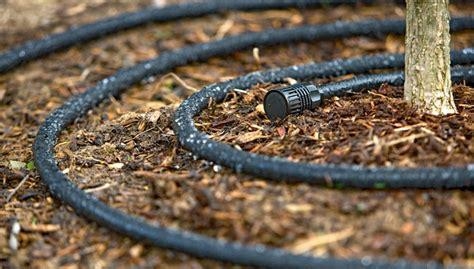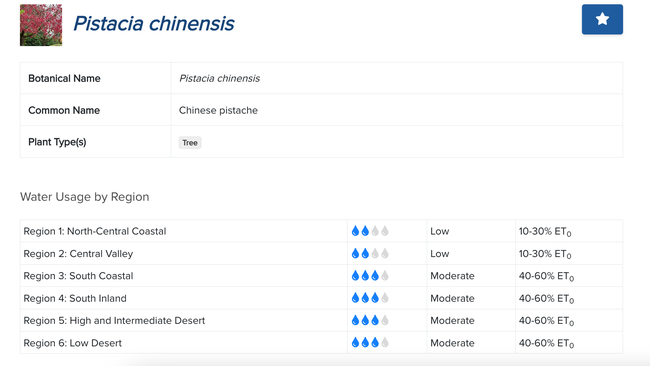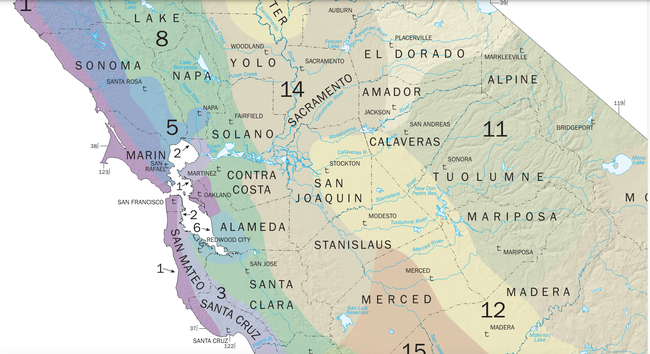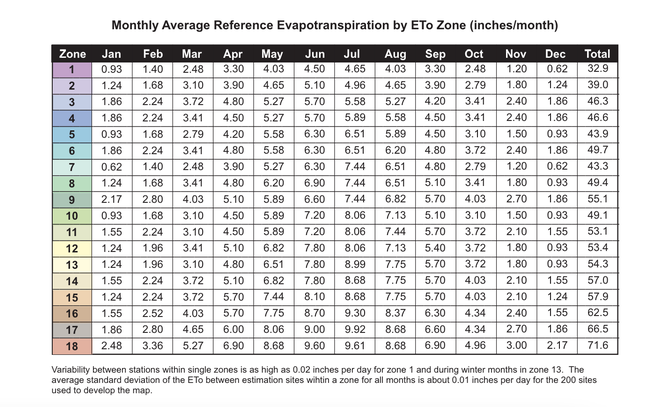The classic answer is, “It depends.” Some of the variables to consider are soil texture and structure, plant choice, season, weather, amount of sunlight and wind, and how well established the plant is. With so many variables, the answer to this question is not simple. The appearance of a plant can suggest a water deficit, but appearance alone is not a reliable indicator of water needs. Unfortunately, many of the symptoms of water deficit— slow growth, wilting, leaf drop, branch dieback, and death—are similar to symptoms of a lack of oxygen, which is commonly caused by overwatering. Other conditions can also cause similar symptoms: root disease, insect injury, herbicide injury, and others. If you suspect your plant's symptoms are caused by lack of water but they don't improve within 24 hours of watering, or if the soil is moist, water deficit is not the cause and you will need to investigate other causes.
General Irrigation Guidelines
Some general guidelines for irrigation are to water early in the morning, to water around the drip line of the plant rather than close to the trunk, to put plants with similar water needs together (hydrozone) and to add a 1'-3” layer of mulch to help keep the soil moist. Roots are encouraged to grow if plants are watered deeply—enough to moisten the soil to just beyond the root zone—and infrequently, rather than shallowly and frequently. A hygrometer, or soil moisture meter, is useful for measuring moisture at the root zone. Follow the directions for use to avoid inaccurate readings.
How will you know how deep the roots are for a particular plant? One way is to carefully dig down to sample the soil around the plant to determine the depth of the roots. An alternative is to estimate the depth of the roots based on the type of plant. The California Master Gardener Handbook gives these ranges for root depth:
- Leafy vegetables and annual bedding plants: top 6 inches to 1 foot
- Cool season turfgrass and flowering perennials: top 6 inches to 1 ½ feet
- Shrubs, trees, ground covers, vines, warm-season turfgrass, and most non-leafy vegetable crops: top 1 to 6 feet (p. 94)
In this article, the focus is on irrigating trees and shrubs, not turf, which is a different situation. The general guidelines above are sufficient in many instances, but you may want a more precise answer for specific plants. Many gardeners tend to overwater rather than underwater; taking the guesswork out of watering can help prevent this.
What is WUCOLS IV?
Fortunately, we have online resources to help determine water needs. The Water Use Classification of Landscape Species, 4th Edition (WUCOLS IV), has been developed by the UC Davis California Center for Urban Horticulture with input from a variety of horticultural professionals. A total of 3,546 species in six different climate regions in California have been evaluated for water needs. San Joaquin County is included in the Central Valley region. The WUCOLS Users Manuel introduces the system; it should be read first to better understand the system. One useful feature of the WUCOLS searchable database is that it allows you to create an overall landscape plan or hydrozone for a portion of a landscape by generating a list of plants specific to your area with similar water needs. But this article will focus on how it can be used to determine the water needs for a particular plant.
It is important to note that the recommended amounts of water given in the WUCOLS database apply only to standard growing conditions, so they do not apply to plants in pots, for instance. These standard growing conditions limit the results to well-established plants growing in the ground in full sun (except when it is a species that requires shade) without variables such as heat reflected from nearby buildings or pavement. The water needs of each plant are given as a percentage range of reference evapotranspiration (ET0).
Evapotranspiration is defined as the process by which water is transferred from the land to the atmosphere by evaporation from the soil and by transpiration from plants. More simply for these purposes, it is the water use of a plant or a planted area. ET0 is a way of standardizing water requirements and is based on the amount of daily water used by 4-inch-tall cool-season turfgrass when soil water is unlimited. Keep in mind that ET0 is not the amount of water required by a plant to remain healthy—that amount is usually less— but rather a reference point. The WUCOLS IV Plant Search Database provides water requirements for each of the plants in its database in all six regions in California by giving the percentage of ET0 required, with species grouped in the following categories:
| Category | Category | Percentage of ET0 |
| High | H | 70-90 |
| Moderate | M | 40-60 |
| Low | L | 10-30 |
| Very Low | VL | <10 |
In the example below, a Chinese pistache tree (Pistacia chinensis), requires a low amount of water in the Central Valley but a moderate amount in the Low Desert region. These classifications consider not only temperature, but additional factors such as wind or whether a species is planted outside of its native range, so sometimes the results seem counterintuitive. Here, for example, it is surprising that the tree would need less water in the Central Valley than in the South Coastal region.
How does CIMIS help?
Once you know the percentage of ET0, needed for a particular plant, the next determination is the ET0 in your area. San Joaquin County falls into two ET0 zones as defined by the California Irrigation Management Information System (CIMIS). The east side of San Joaquin County is in zone 12; the west side (roughly west of the San Joaquin River) is in zone 14.
(Figure 3)
CIMIS provides hourly, daily, and monthly reports of total ET0 and other useful data gathered from sites throughout California, as well as the monthly averages listed below in Figure 4.
Using This Information
Taking the Chinese pistache tree in Stockton (zone 12) as an example, we see that in the month of July it requires 10-30% of 8.06 inches of water, or 0.81” to 2.42”. This could be applied as a deep watering once during the month or divided into two waterings of 0.4” to 1.21” each. Sandy soil requires more frequent watering than clay soil, which doesn't drain as quickly.
How would you apply an inch of water to a tree? To determine this, two more steps are required. First, the size of the canopy of the tree or shrub indicates the number of square feet that require water. If the canopy is 10 feet in diameter, the radius is half of that, or 5 feet. The formula for determining the number of square feet in a circle is
Pi (3.14) x radius squared = square feet
Thus, a tree with a diameter of 10 feet has a radius of 5 feet, and the calculation would be
3.14 x (52) = 78.5 square feet.
Next, given that 0.62 gallons of water provides an inch of water per square foot, you can calculate how many gallons to provide. Following the above example of a tree canopy that covers 78.5 square feet, if you determine that the tree needs 1.62 inches of water (20% ET0) in July, use the following formula to convert inches of water into gallons:
Square feet x inches of water x 0.62 = gallons of water
In this example, the tree canopy is 78.5 square feet, and it needs an average of 1.62 inches of water in the month of July, so you would calculate 78.5 x 1.62 x 0.62 = 78.85 gallons. If you divided that into two waterings during the month, you would apply 39.5 gallons at each watering.
How will you measure the number of gallons you are applying? Drip system emitters are labeled with the amount of water they deliver per hour—usually 1-3 gallons, so the number of emitters per plant would determine how long to water. When using a garden hose, one way to determine how much water you are applying is to turn on the water to the force you plan to use—remembering that watering “low and slow” is best because it allows the water to sink in. Next, measure how much time it talks to fill a gallon container. A slow trickle may require 4 minutes to fill a gallon container. Then, for instance, if you determine your tree needs 40 gallons of water and it takes 4 minutes to apply a gallon of water, you will have to water for 160 minutes to achieve that. It is also possible to purchase a flow meter that can be attached to your hose that gives a digital readout of the flow rate and total water emitted. This is a more precise way of measuring, and you can vary the flow rate while still measuring the total amount applied. When watering under a large tree canopy, it is best to water apply water at the drip line or with a soaker hose arranged in a spiral as in Figure 1 above.
Keep in mind that the final number you arrive at is just a starting point. Your plant or tree will require less water if it is in partial shade and more if it is affected by light reflected off cement or asphalt, for instance, so careful observation is still necessary.
Following the general guidelines for watering are useful, but you may wish to delve deeper into the question of how much water to give your plants by going “into the weeds” and using more precise methods. This may seem like a lot of work, but if you are trying to keep valuable trees and shrubs healthy while conserving water, taking advantage of these carefully developed resources can help you do that. Determining the appropriate amount of water for your plants is more important than ever, as water becomes an increasingly scarce resource.
References:
California Irrigation Management Information System: Reference Evapotranspiration Zones
Laurence, R.C., et al. 2003. Abiotic Disorders of Landscape Plants: A Diagnostic Guide. University of California, Agriculture and Natural Resources Publication 3420.
Native Gardening 101: Watering Native Plants
Pittenger, D.R., ed. California Master Gardener Handbook, Second Edition. Chapter Four: Water Management. University of California, Agriculture and Natural Resources Publication 3382.



